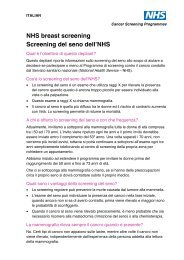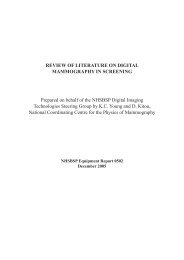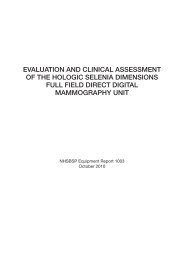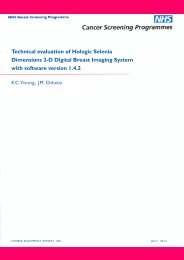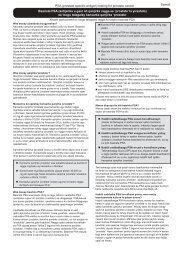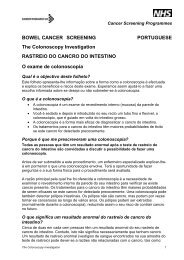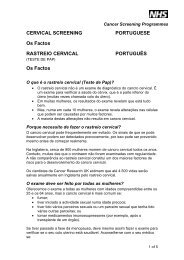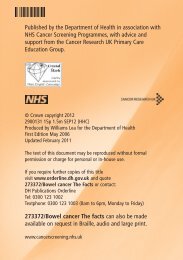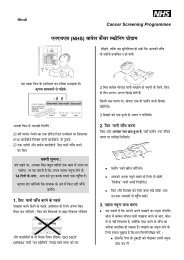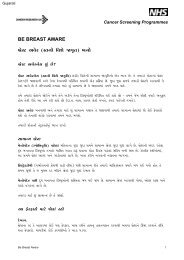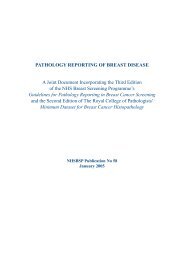reporting lesions in the nhs bowel cancer screening programme
reporting lesions in the nhs bowel cancer screening programme
reporting lesions in the nhs bowel cancer screening programme
Create successful ePaper yourself
Turn your PDF publications into a flip-book with our unique Google optimized e-Paper software.
Report<strong>in</strong>g Lesions <strong>in</strong> <strong>the</strong> NHS Bowel Cancer Screen<strong>in</strong>g Programme | 1<br />
1. INTRODUCTION<br />
1.1 Background<br />
The NHS Bowel Cancer Screen<strong>in</strong>g Programme (NHS BCSP) will, <strong>in</strong> due course, become <strong>the</strong> largest<br />
<strong>programme</strong> for <strong>bowel</strong> <strong>cancer</strong> screen<strong>in</strong>g <strong>in</strong> <strong>the</strong> world. It offers a unique opportunity to improve<br />
survival <strong>in</strong> this condition as well as clarify<strong>in</strong>g <strong>the</strong> importance of current diagnostic criteria and identify<strong>in</strong>g<br />
<strong>the</strong> biological potential of precursors of colorectal <strong>cancer</strong>.<br />
These guidel<strong>in</strong>es are produced under <strong>the</strong> auspices of <strong>the</strong> NHS BCSP. They have been derived<br />
to answer many of <strong>the</strong> questions that have arisen with<strong>in</strong> <strong>the</strong> pilot screen<strong>in</strong>g centres <strong>in</strong> England<br />
and Scotland, to ensure that key data are collected <strong>in</strong> a consistent manner and to enable fur<strong>the</strong>r<br />
recommendations to be made to provide <strong>the</strong> best possible evidence base for rout<strong>in</strong>e practice. We<br />
welcome feedback and will develop <strong>the</strong>se guidel<strong>in</strong>es as <strong>the</strong> evidence base improves. We are striv<strong>in</strong>g<br />
to ensure consistency across <strong>the</strong> UK and between <strong>the</strong> published recommendations of concerned<br />
professional organisations such as <strong>the</strong> Royal College of Pathologists, <strong>the</strong> British Society of Gastroenterology<br />
and <strong>the</strong> Association of Coloproctology of Great Brita<strong>in</strong> and Ireland. We have also built<br />
on <strong>the</strong> pathology work undertaken dur<strong>in</strong>g <strong>the</strong> Cancer Research UK (CRUK) flexisigmoidoscopy<br />
trial by adopt<strong>in</strong>g many of <strong>the</strong> def<strong>in</strong>itions we developed for that trial. These guidel<strong>in</strong>es are consistent<br />
with <strong>the</strong> dataset produced by <strong>the</strong> Royal College of Pathologists for <strong>report<strong>in</strong>g</strong> colorectal <strong>cancer</strong><br />
(<strong>in</strong>clud<strong>in</strong>g local excision specimens) and will be developed closely with <strong>the</strong>m <strong>in</strong> <strong>the</strong> future.<br />
1.2 General issues<br />
Dysplasia is divided <strong>in</strong>to low and high grade to improve <strong>in</strong>terobserver agreement, with ‘high grade<br />
dysplasia’ equat<strong>in</strong>g to ‘severe dysplasia’ <strong>in</strong> older systems. 1 The term hyperplastic ra<strong>the</strong>r than metaplastic<br />
polyp is recommended; nei<strong>the</strong>r is a good name, but add<strong>in</strong>g a third only confuses matters<br />
fur<strong>the</strong>r. The reasons for recommend<strong>in</strong>g <strong>the</strong> term hyperplastic are that, firstly, it has been used <strong>in</strong><br />
both pilot centres; secondly, true metaplasia (eg squamous islands) can rarely occur <strong>in</strong> dysplastic<br />
adenomas; and, thirdly, <strong>the</strong> term metaplastic is def<strong>in</strong>ed as a change <strong>in</strong> epi<strong>the</strong>lial type from one<br />
mature epi<strong>the</strong>lial type to ano<strong>the</strong>r. Although <strong>the</strong> epi<strong>the</strong>lium of a hyperplastic lesion is abnormal, it is<br />
not of a different epi<strong>the</strong>lial type. Different antigenic patterns have been demonstrated <strong>in</strong> hyperplastic<br />
polyps, but are not those of ano<strong>the</strong>r mature epi<strong>the</strong>lial type. Polyps have been broadly subclassified<br />
<strong>in</strong>to classical, hyperplastic serrated spectrum and o<strong>the</strong>r types of lesion. We have concentrated on<br />
early <strong>in</strong>vasive <strong>lesions</strong> as <strong>the</strong>se have proved challeng<strong>in</strong>g with<strong>in</strong> <strong>the</strong> pilot screen<strong>in</strong>g centres, <strong>the</strong> evidence<br />
base is currently poor and <strong>the</strong> national screen<strong>in</strong>g <strong>programme</strong> will generate many of <strong>the</strong>se<br />
difficult <strong>lesions</strong>. We have also sought to identify <strong>the</strong> serrated spectrum to allow fur<strong>the</strong>r <strong>in</strong>vestigation<br />
<strong>in</strong> this area.<br />
The target for histopathology <strong>report<strong>in</strong>g</strong> is that 90% of <strong>lesions</strong> should be reported with<strong>in</strong> 7 days. This<br />
will allow patients who have had a polyp removed at colonoscopy to be given an appo<strong>in</strong>tment to<br />
be seen <strong>the</strong> follow<strong>in</strong>g week <strong>in</strong> <strong>the</strong> follow-up cl<strong>in</strong>ic.<br />
Pathologists must complete ei<strong>the</strong>r <strong>the</strong> screen<strong>in</strong>g <strong>programme</strong> proforma or its computerised version.<br />
These are to be returned to <strong>the</strong> screen<strong>in</strong>g centre adm<strong>in</strong>istrator for pathology data to be entered<br />
onto <strong>the</strong> <strong>bowel</strong> <strong>cancer</strong> screen<strong>in</strong>g system (BCSS). Pathologists may also wish to provide a free text<br />
report directly to <strong>the</strong> cl<strong>in</strong>ician.<br />
A copy of <strong>the</strong> latest version of <strong>the</strong> proforma can be found at www.virtualpathology.leeds.ac.uk/<br />
nbcs/nbcs.php.<br />
NHS BCSP September 2007



